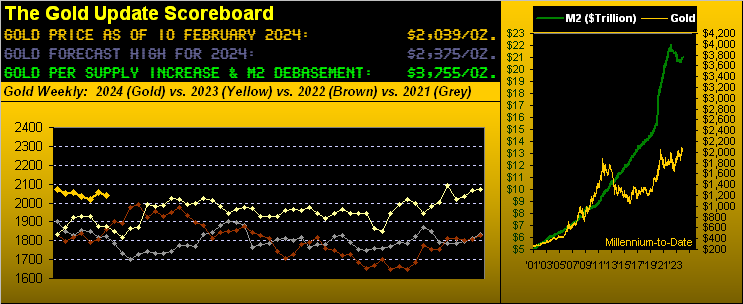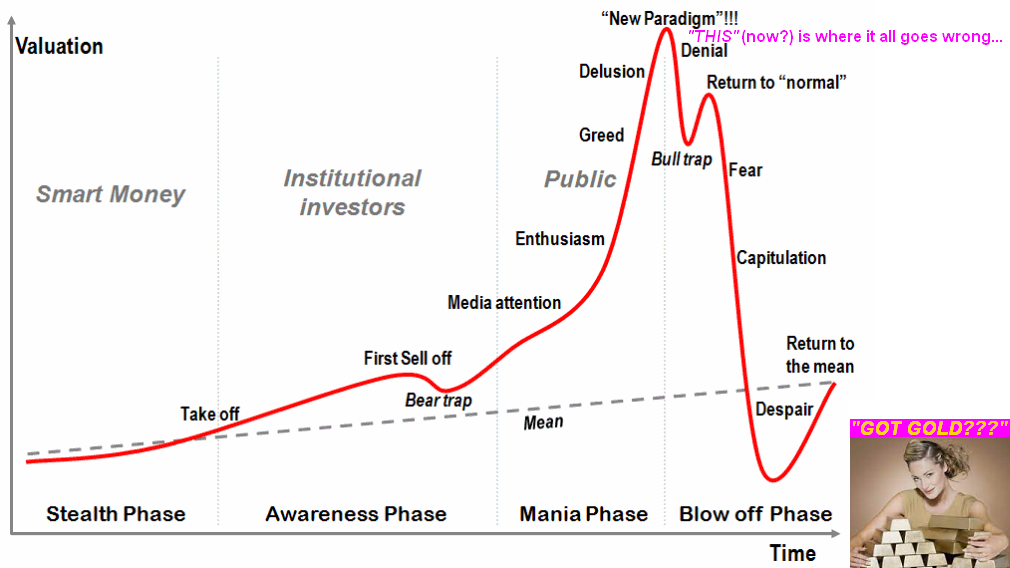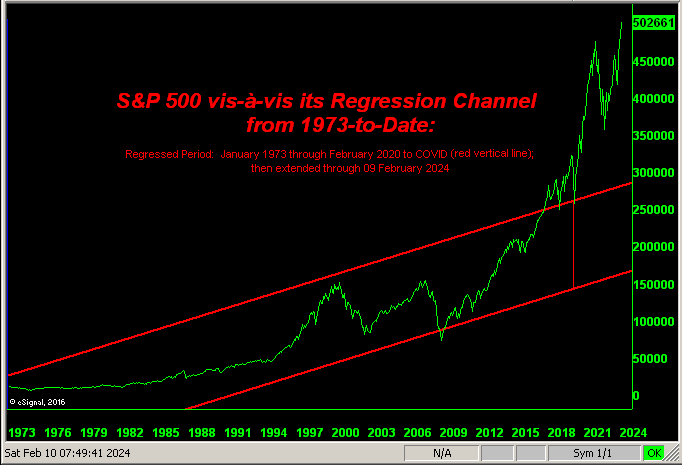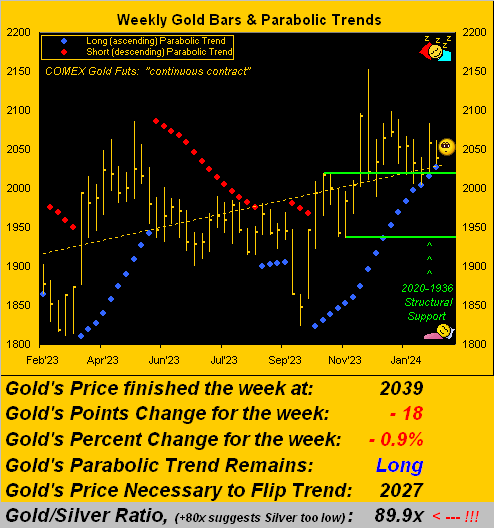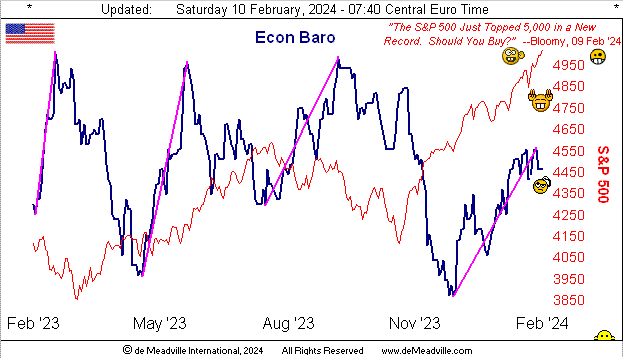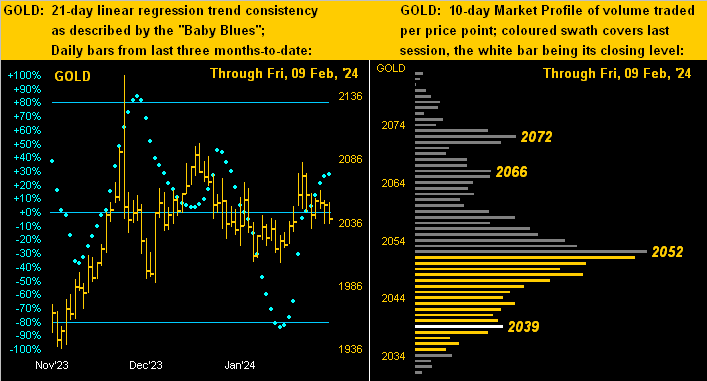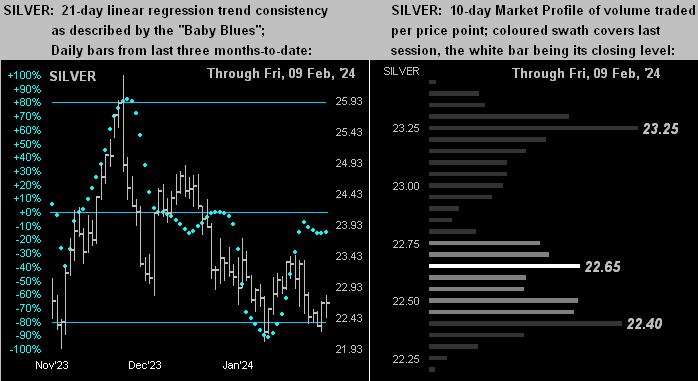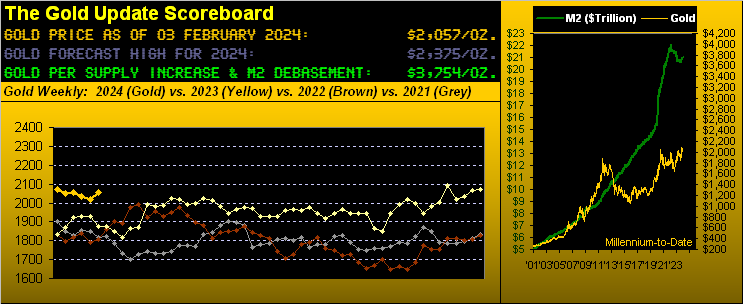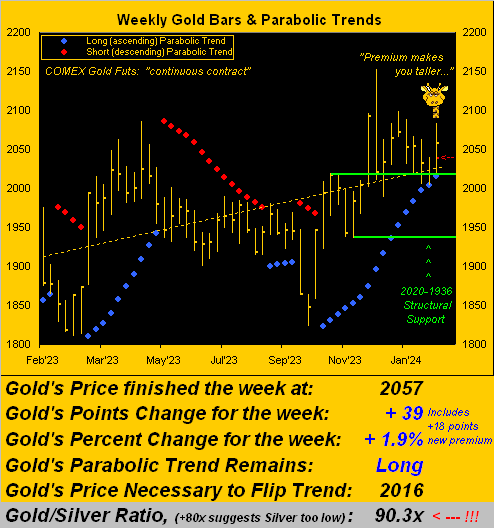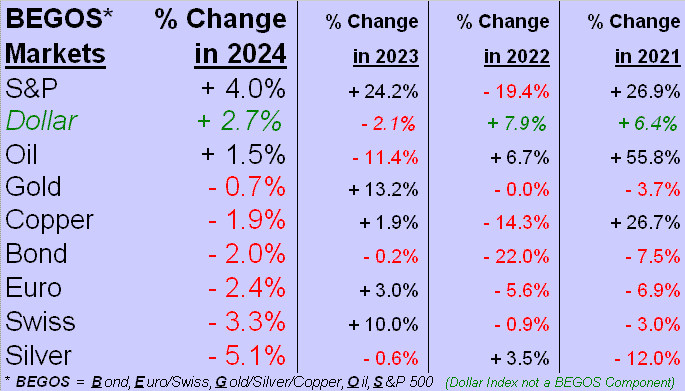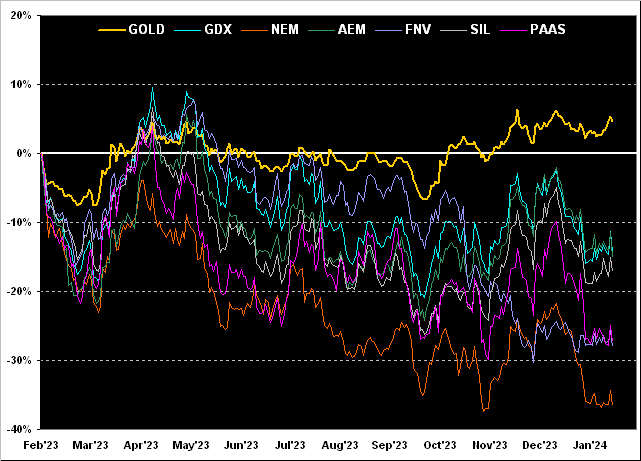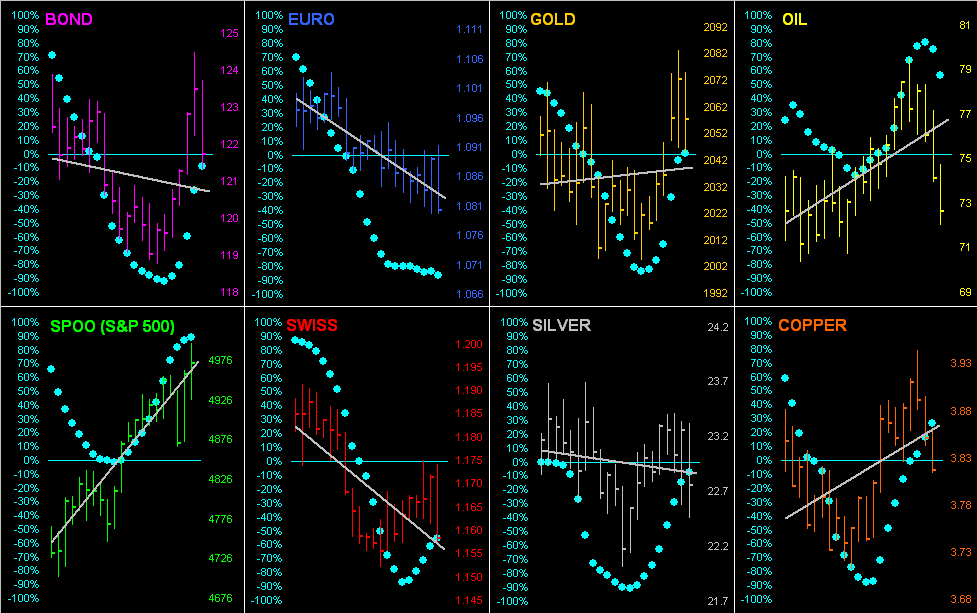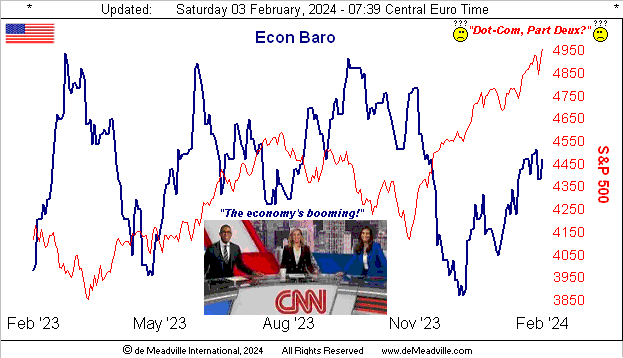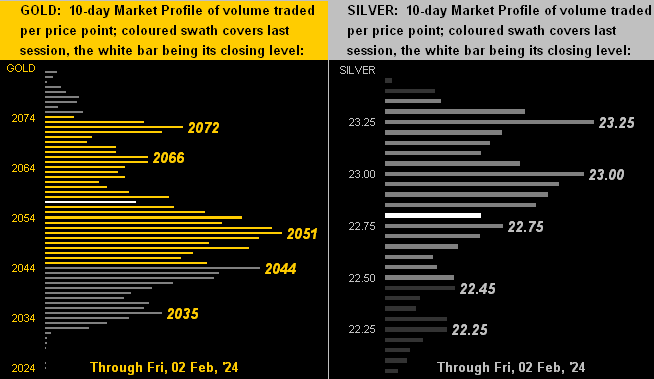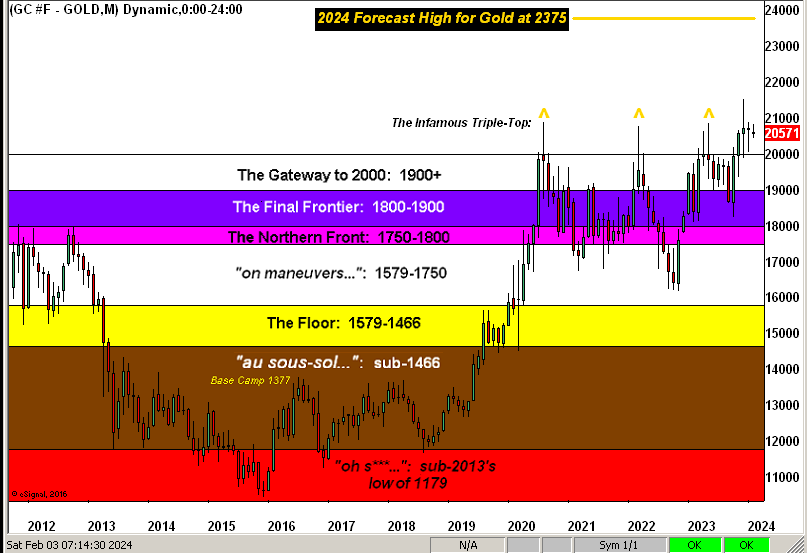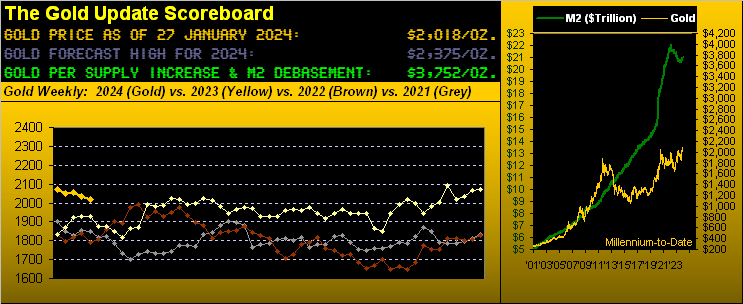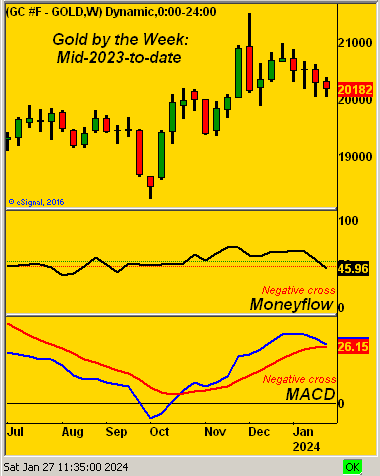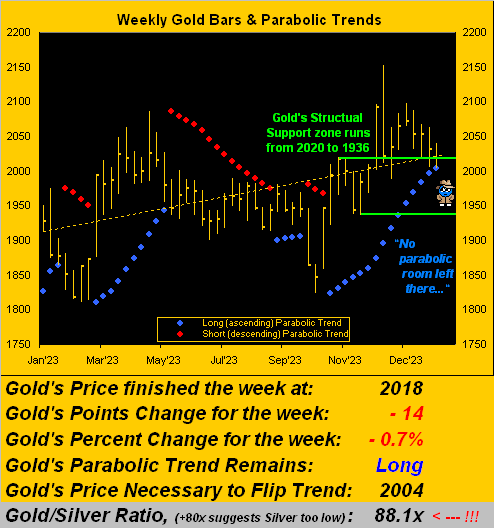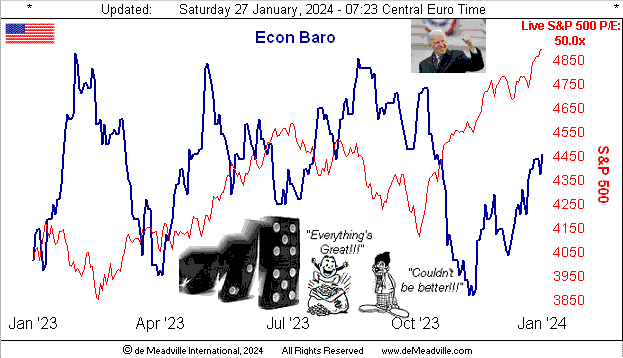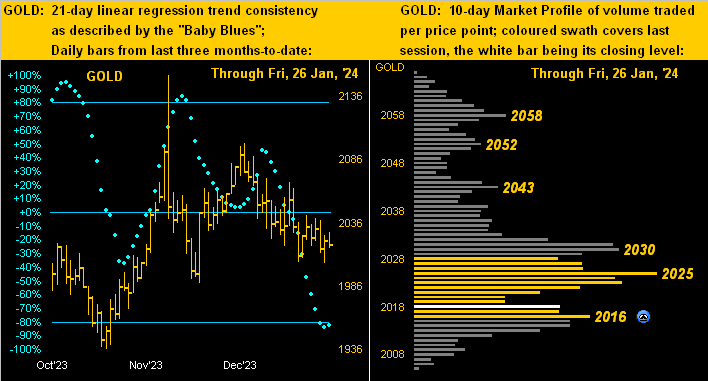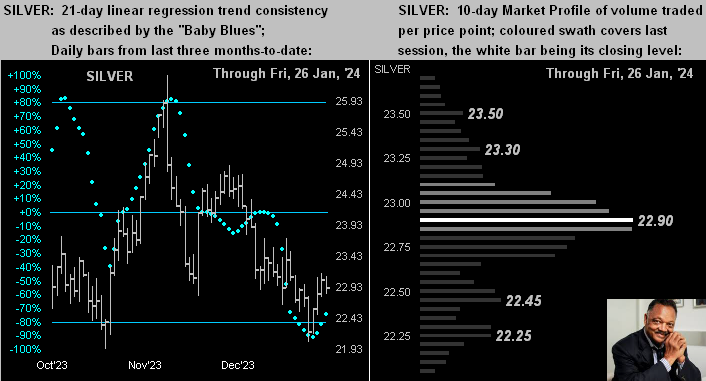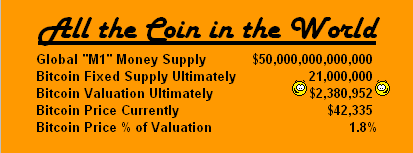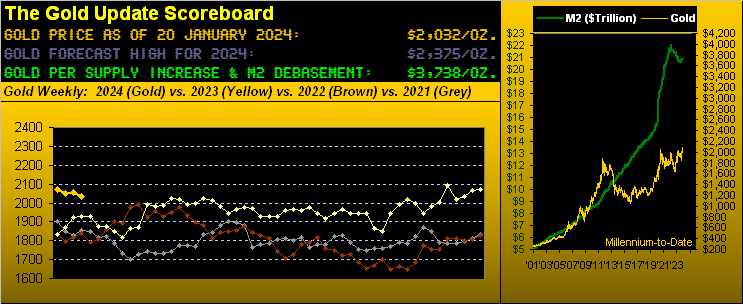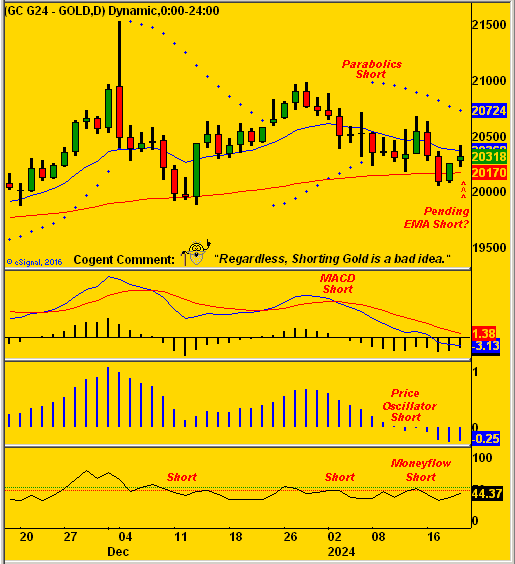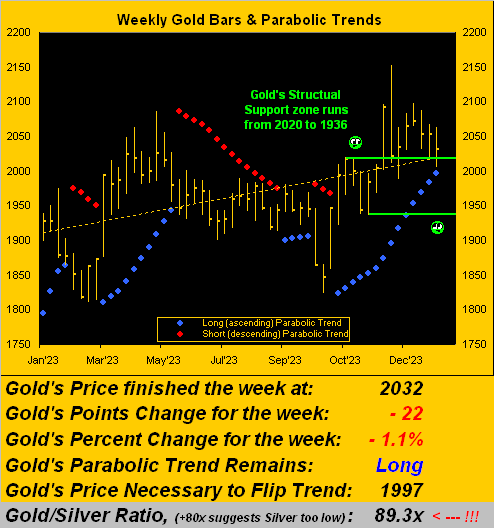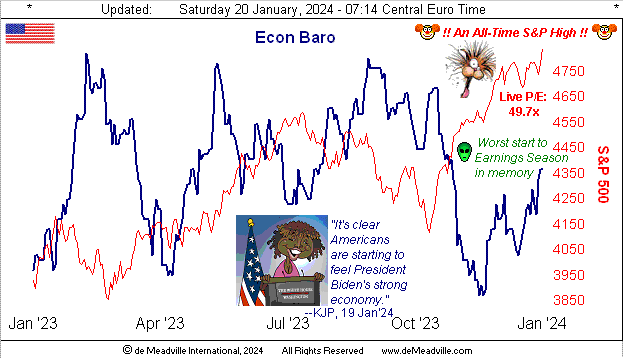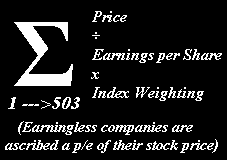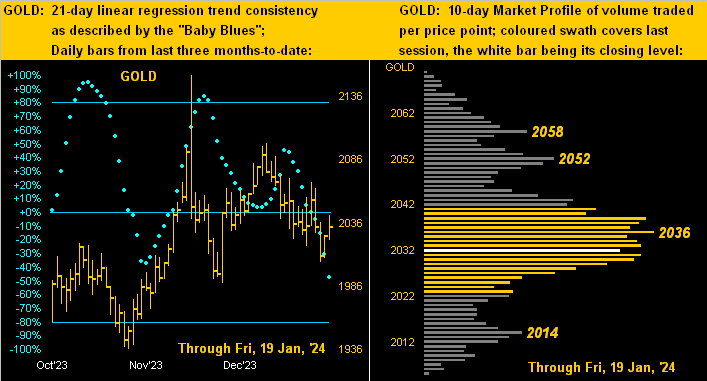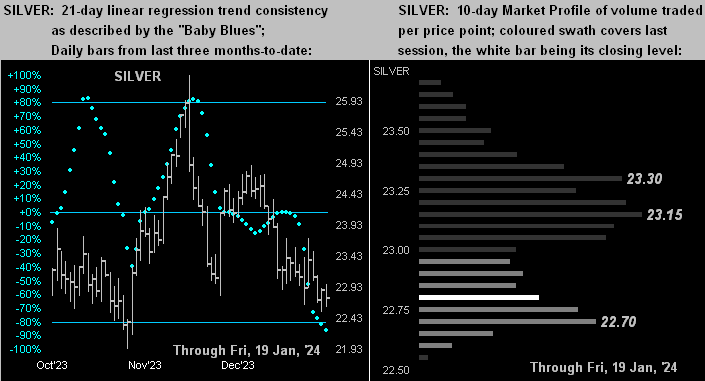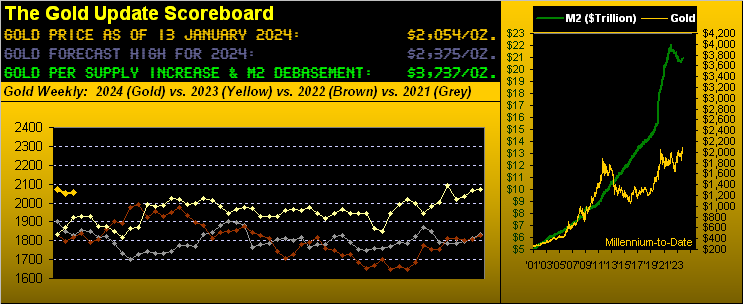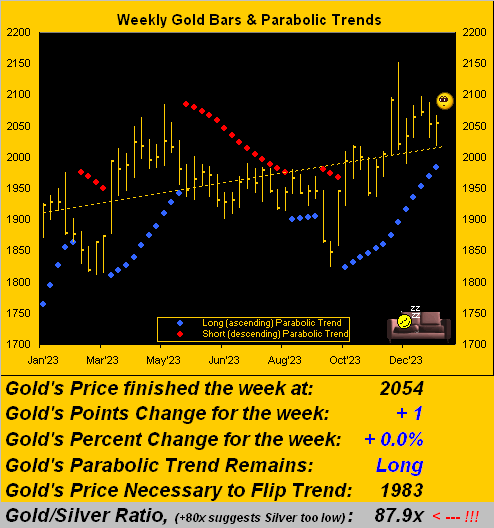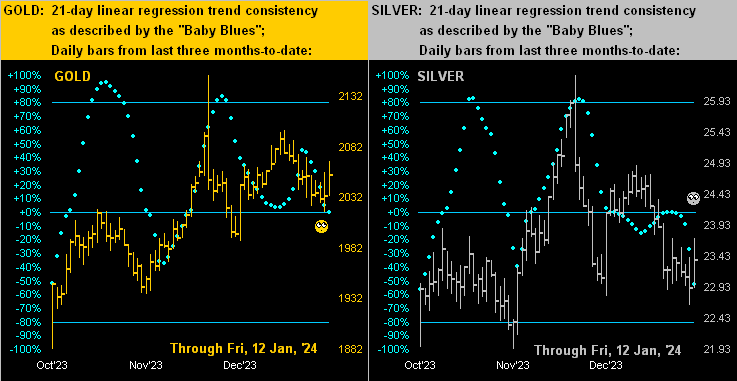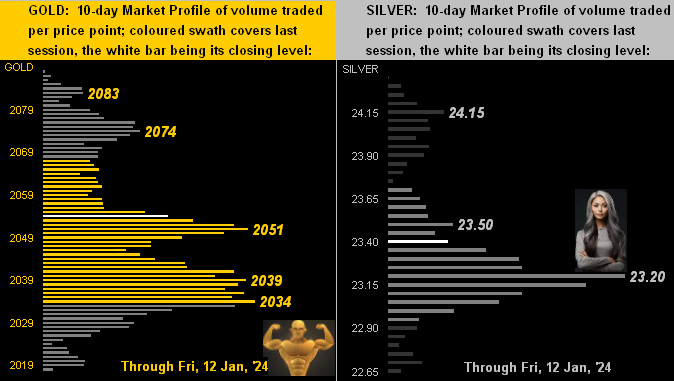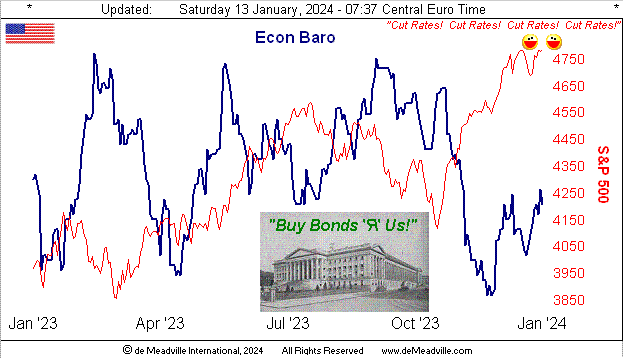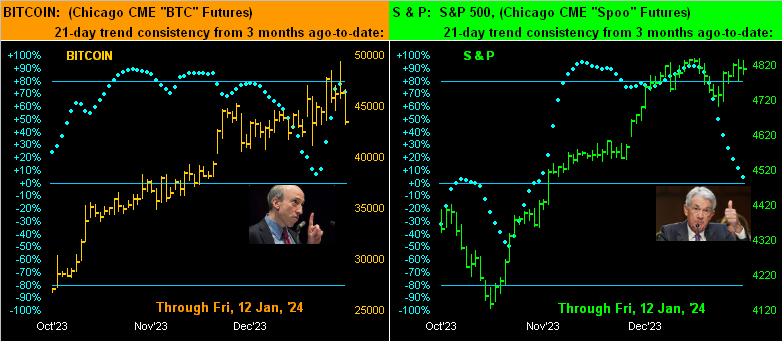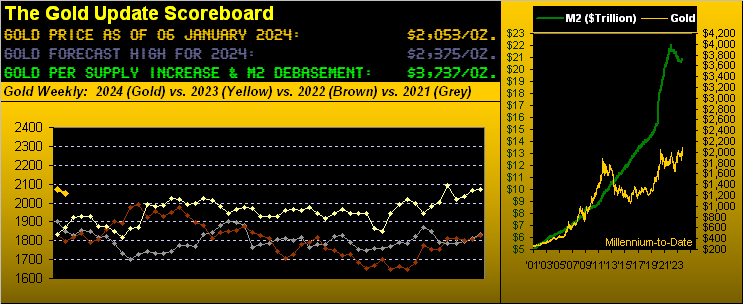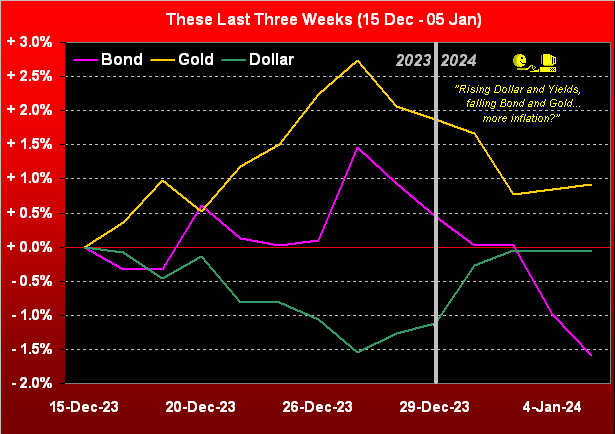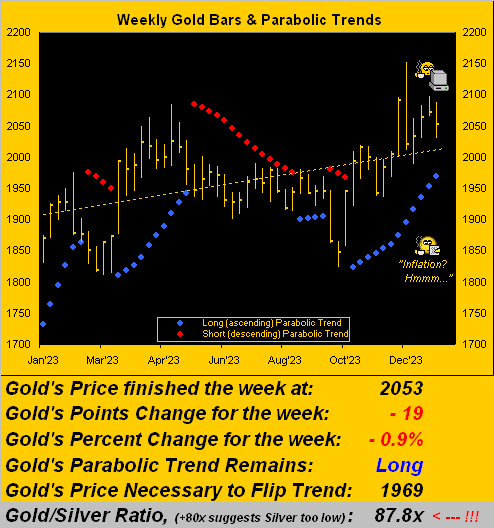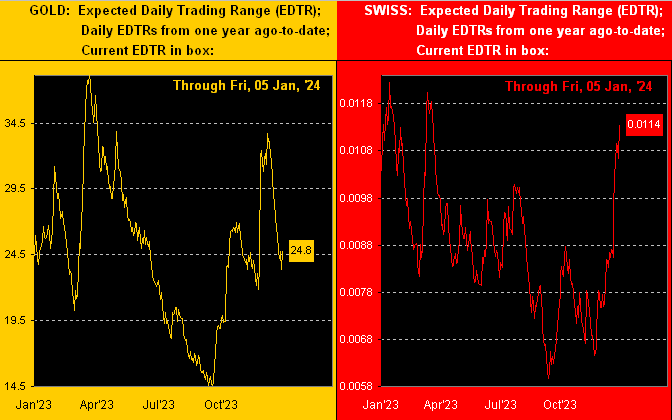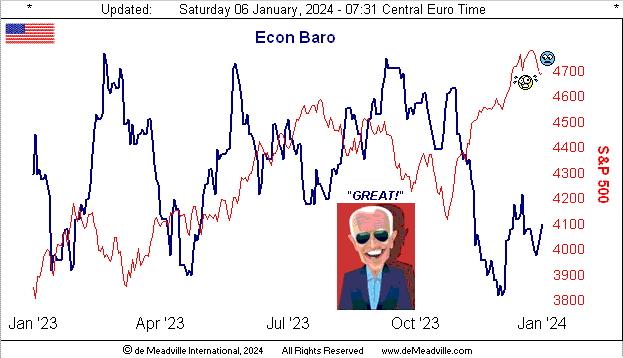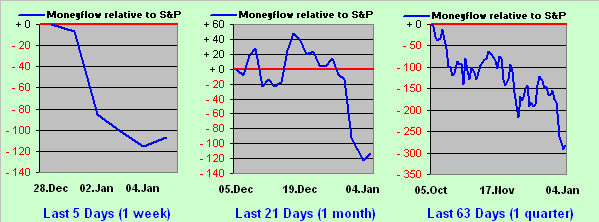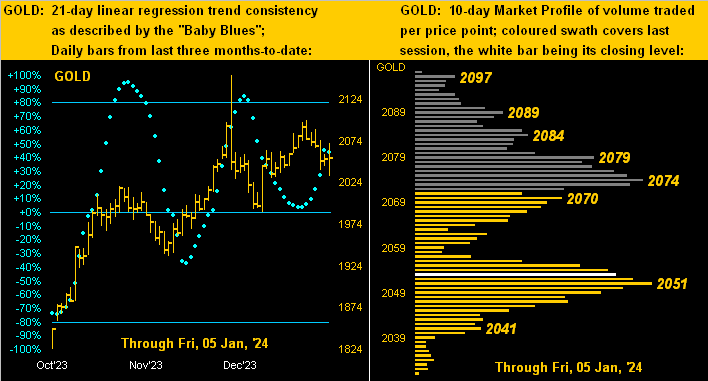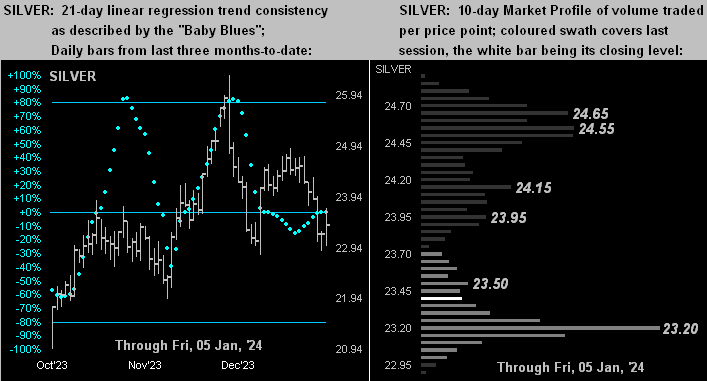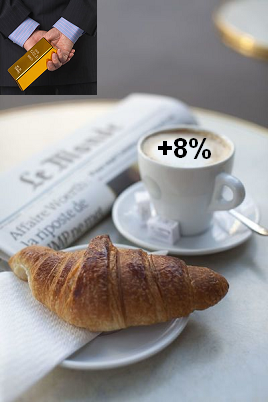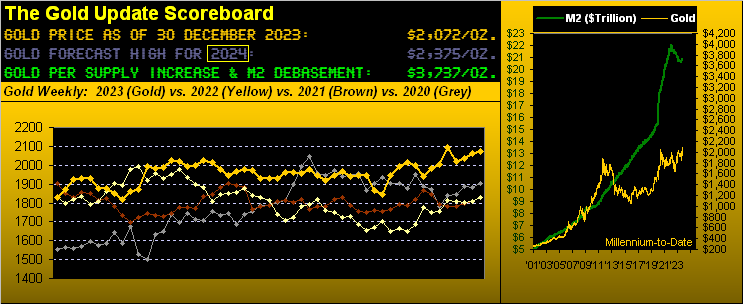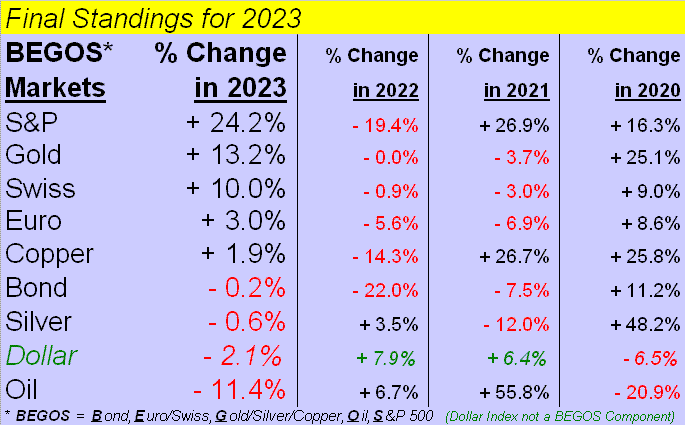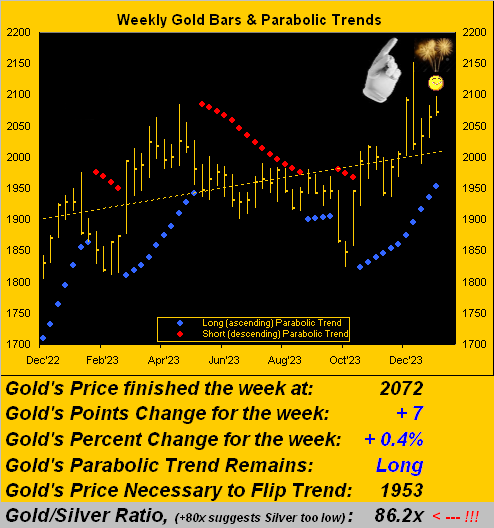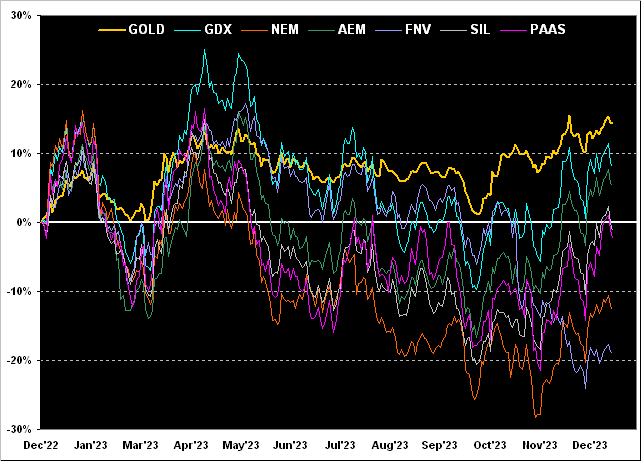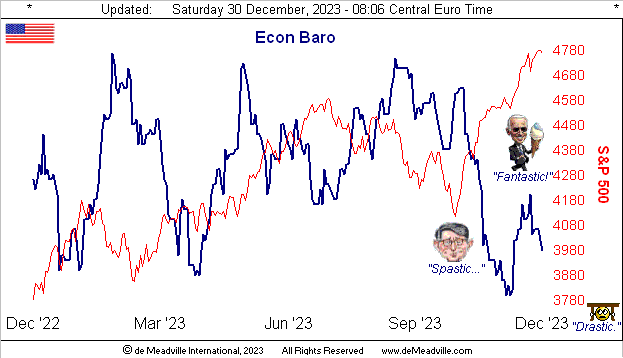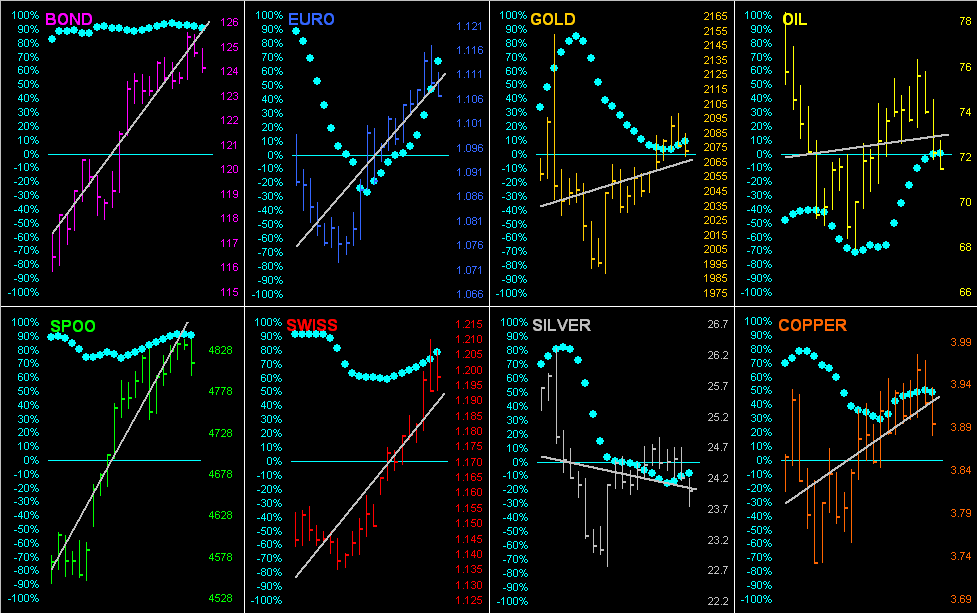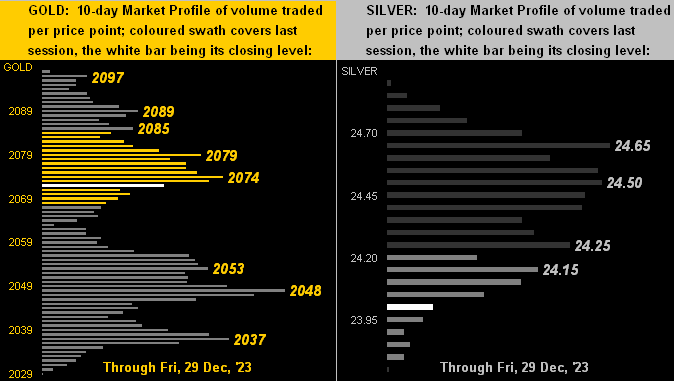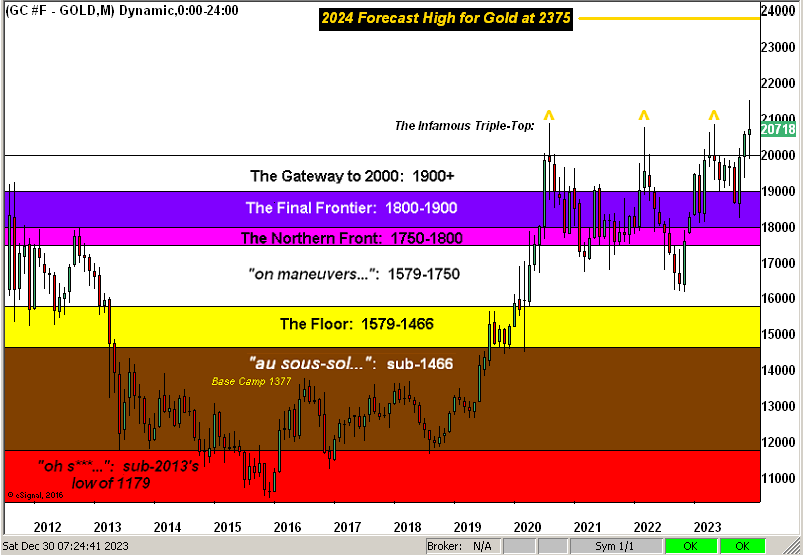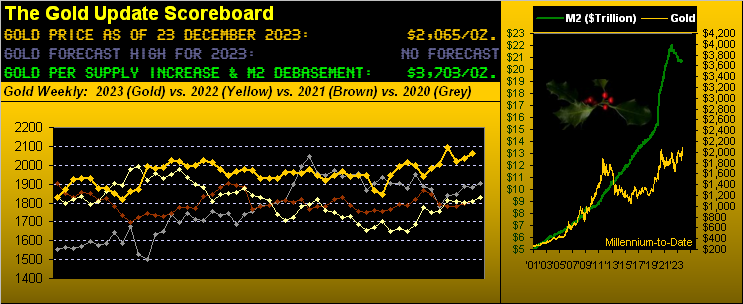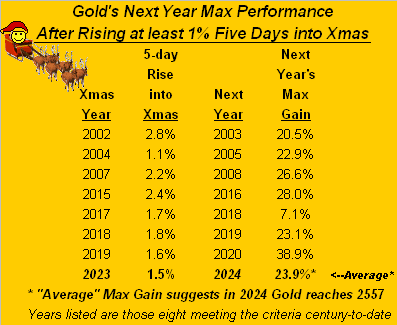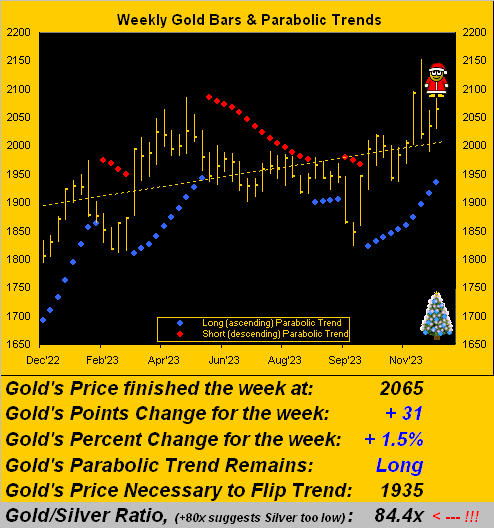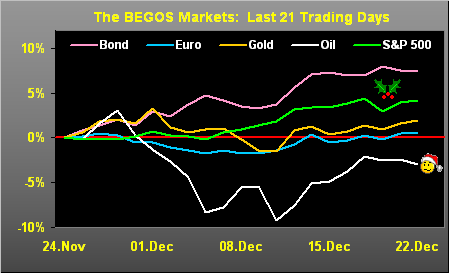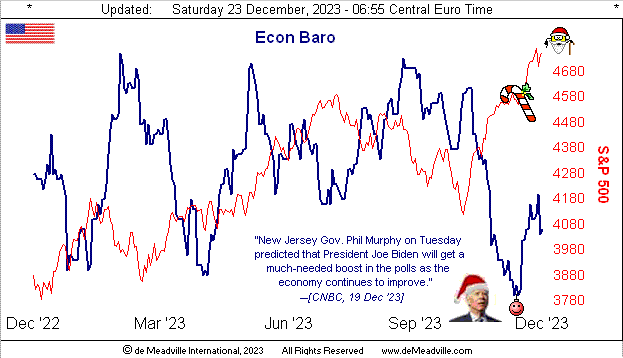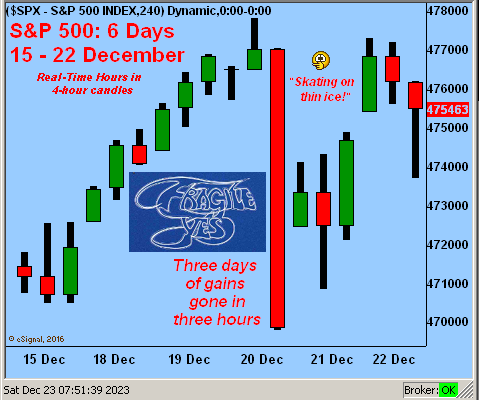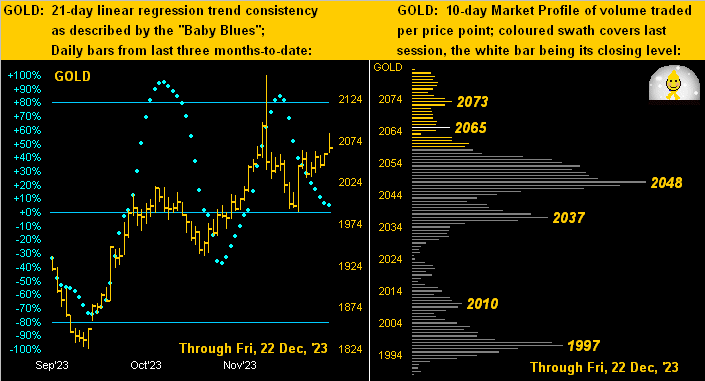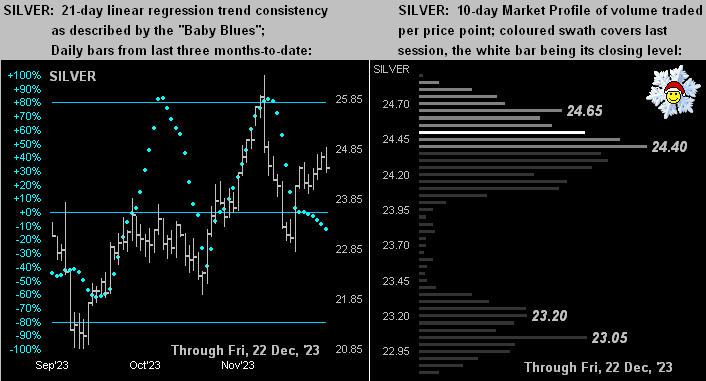The Bond and Swiss Franc are at present below their respective Neutral Zones for today; above same is Copper, and volatility is mostly light, (the red metal the sole component having already traded in excess of 50% [54%] of its EDTR [see Market Ranges]). At Market Trends, save for Oil and the Spoo, the other six BEGOS Markets are in linreg downtrends. And in going ’round the horn in real-time for the five primary components’ Market Values: the Bond is better than -4 points “low” per its smooth valuation line, the Euro -0.023 points “low”, Gold -36 points “low”, Oil nearly +4 points “high”, and the Spoo +185 points “high”. The Econ Baro concludes its very busy week with February’s UofM Sentiment Survey, plus January’s PPI and Housing Starts/Permits.
 Mark
Mark
15 February 2024 – 09:13 Central Euro Time
We’ve at present both the Bond and Swiss Franc above today’s Neutral Zones; the balance of the BEGOS Markets are within same, and volatility is light. Looking at Market Rhythms, on a 24-test wing basis for consistency, Copper’s 30mn Parabolics ranks 1st. By Market Trends, Copper’s “Baby Blues” are in decline, as are those for all the other components, save for the Spoo, the Market Value for which (in real-time) is +170 points above its smooth valuation line. The “live” P/E of the S&P (fut’s adj’d) is 49.7x. ‘Tis a massive set of incoming metrics (11) for the Econ Baro today: included therein are February’s NY State Empire Index, Philly Fed Index and NAHB Index, plus January’s Retail Sales, Ex/Im Prices and IndProd/CapUtil, plus December’s Business Inventories.
14 February 2024 – 09:19 Central Euro Time
Silver of late seems to oft be the BEGOS Markets’ sole overnight outlier: ’tis at present below its Neutral Zone for today, whilst all the other components are within same; volatility is quite light with Copper sporting the widest EDTR tracing (see Market Ranges) of just 38% to this point. As perhaps provocatively put at times year-to-date in The Gold Update: what if the Fed had to again raise rates to battle increasing inflation? (January’s “Fed-favoured” Core PCE pace is not due until 29 February). With better than two weeks still to run in Q4 Earnings Season, it remains that 4 in 10 S&P 500 constituents have not improved their year-over-year bottom lines. At Market Values, despite the -1.4% drop yesterday in the S&P, the Spoo (in real-time) is still 133 points above its smooth valuation line; the Index itself is 18 consecutive trading days “textbook overbought” and the “live” (futs-adj’d) P/E is now 47.8x, essentially double where ’twas when first established a dozen years ago.
13 February 2024 – 09:18 Central Euro Time
At present the Swiss Franc is below today’s Neutral Zone, whilst above same are all three elements of the Metals Triumvirate; volatility is mostly light. As anticipated both in yesterday’s commentary and the current edition of The Gold Update, the yellow metal’s weekly parabolic trend — after having been Long for 17 weeks — has provisionally flipped to Short, confirmation of which shall come at Friday’s settle, (barring a rocket shot above 2152); as noted, this technically opens the door for further testing of the 2020-1936 support structure; strictly on a swing basis for consistency, Gold’s best Market Rhythm is currently the 4hr Moneyflow. We’re notably eying the Core CPI in today’s retail inflation data for the Econ Baro: such Core reading may indicate inflation running at a +3.6% pace.
12 February 2024 – 09:35 Central Euro Time
The BEGOS Markets start the week with Silver as the sole component at present outside (above) its Neutral Zone for today; session volatility is mostly light, save for the white metal having already traced 82% of its EDTR (see Market Ranges). The Gold Update notes the narrowness of the yellow metal’s trade of late, with the likelihood the weekly parabolic Long trend shall now flip to Short; emphasis is placed on the S&P 500’s ongoing overvaluation and potential positioning within the stock market’s broad-based “emotional” cycle, suggestive of the Index having reached the inflexion point from where “it all goes wrong.” The Econ Baro’s busy week of 17 incoming metrics begins with January’s Treasury Deficit.
09 February 2024 – 09:25 Central Euro Time
All eight BEGOS Markets are at present within their respective Neutral Zones for today; session volatility is very light. The S&P 500 briefly topped the 5000-mark yesterday (at precisely 5000.40) before settling at 4998. Four in ten S&P stocks have thus far not improved their Q4 earnings over those of a year ago. Infamous Dave Einhorn just referred to the markets as “fundamentally broken”; (obviously he reads The Gold Update … more on that in tomorrow’s 743rd edition). Our top Market Rhythms for consistency on a 10-test swing basis are currently the Bond’s daily Parabolics, both the Swiss Franc’s 8hr Moneyflow and daily Parabolics, and the Spoo’s 2hr Price Oscillator. The Econ Baro already has concluded its muted week.
08 February 2024 – 09:16 Central Euro Time
The Spoo is now above 5000 for the first time in its history, (the S&P itself near the threshold). At present we’ve both Silver and Copper above their Neutral Zones for today; the rest of the BEGOS Markets are within same, and volatility is light. Per our S&P Moneyflow page, dough is flowing into the Index at an unbelievable rate given the more-than-extreme overvaluation: the “live” P/E (fut’s adj’d) is now 50.2x. Today’s Econ Baro metrics include December’s Wholesale Inventories.
07 February 2024 – 09:39 Central Euro Time
At present, Gold and Silver are the only BEGOS Market outside (below) today’s Neutral Zone; session volatility again is notably light. Of late we’ve a strong positive correlation between the Bond and Gold: indeed the tracks of their daily bars across the past 21 trading days (one month) are (to the glance) identical. We continue to monitor Gold’s weekly technicals, the Moneyflow for which is inching lower still; again a retest of the 2020-1936 can be in the cards, certainly upon the weekly parabolic Long trend flipping to Short, (the hurdle for which is currently 2015 versus price right now of 2048). The Econ Baro looks to December’s Trade Deficit and (late in the session) Consumer Credit.
06 February 2024 – 09:14 Central Euro Time
The Spoo is the sole BEGOS Market at present outside (above) its Neutral Zone for today; session volatility is notably light, even as nothing is on the schedule for the Econ Baro. Our top three Market Rhythms (on a 10-test swing basis) for consistency are Gold’s 1hr Moneyflow, the Swiss Franc’s 8hr Moneyflow, and the Spoo’s 2hr Price Oscillator. Going ’round the Market Values horn for the five primary components, in real-time we’ve the Bond as -2^22 points “low” vis-à-vis its smooth valuation line, the Euro as -0.022 points “low’, Gold as just -10 points “low”, Oil as basically spot-on its valuation line, and the Spoo as +172 points “high”. At Market Trends, those with positive linregs are Gold, Copper, Oil and the Spoo; thus those negative are the Bond, Euro Swiss Franc and Silver. Through yesterday, only 57% of S&P 500 companies’ Q4 earnings are better than a year ago, with many reports still in the balance over these next couple of weeks.
05 February 2024 – 09:20 Central Euro Time
The Bond and Precious Metals are starting the week to the downside; the balance of the BEGOS Markets are within today’s Neutral Zone, and volatility is pushing toward moderate; Gold already has traced 75% of its EDTR (see Market Ranges). The Gold Update accounts for 19 fresh points of premium in the April contract, but remains wary of some near-term price setback; too, mention is made of Dot-Com-like worries by Big Banks, (an issue upon which we’ve repeated these last several months). The “live” (futs-adj’d) P/E of the S&P 500 is 51.0x: 98 earnings reports are scheduled for the Index this week. The Econ Baro begins a very light data week with January’s ISM(Svc) Index.
02 February 2024 – 09:20 Central Euro Time
Quick website note: our Market Profiles page is not accurately updating; our goal is to have the issue resolved in a week’s time. <– Resolved. To the BEGOS Markets we go and at present Copper is the sole component outside (below) its Neutral Zone; session volatility is light, save for Copper having already traced 82% of its EDTR (see Market Ranges). Yesterday’s equities’ upside whirl-’round now finds the Spoo (in real-time) +158 points above its smooth valuation line (see Market Values); the S&P 500 itself is now 10 consecutive trading days “textbook overbought”. The Econ Baro awaits January’s Payrolls and revised UofM Sentiment Survey, plus December’s Factory Orders.
01 February 2024 – 09:48 Central Euro Time
The Bond, EuroCurrencies, Silver and Copper all are below today’s Neutral Zones; above same is the Spoo, and BEGOS Markets volatility is moderate. The data provider’s EPS issue appears to have been resolved such that the S&P Valuation and Rankings page shall resume updating tonight. Yesterday’s -1.6% drop in the S&P 500 was its worst since 21 September. Credit the FinMedia for having really fueled belief for a more dovish FOMC presentation. Despite the S&P’s decline, the Spoo (in real-time) is +97 points above its smooth valuation line (see Market Values). ‘Tis a busy day for the Econ Baro including Januarys’ ISM(Mfg), December’s Construction Spending and Q4’s first peek at Productivity and Unit Labor Costs.
31 January 2024 – 09:17 Central Euro Time
Ahead of the Fed, both the Euro and Swiss Franc are at present below today’s Neutral Zones; the balance of the BEGOS Markets are within same, and volatility is light-to-moderate, the Euro notably having already traced 65% of its EDTR (see Market Ranges). As we saw on Monday with both the Bond and Gold, the Swiss Franc’s “Baby Blues” (see Market Trends) have moved above their -80% axis; as our regular readers know, this is indicative of higher prices ahead, albeit for the yellow metal, the negative weekly measures discussed in The Gold Update have us cautious. In addition to the FOMC’s Policy Statement, we’ve for the Econ Baro today December’s ADP Employment data and the Chi PMI, plus Q4’s Employment Cost Index.
30 January 2024 – 09:28 Central Euro Time
‘Tis quiet across the BEGOS Markets’ landscape, all eight components at present within their respective Neutral Zones for today; volatility is mostly light. Looking at the most consistent Market Rhythms, we’ve (on a 10-test swing basis) the Euro’s 1hr parabolics and (on a 24-test swing basis) both Silver’s 1hr Moneyflow and the Spoo’s 8hr Moneyflow. For the S&P itself (the “live” futs-adj’d P/E now 50.9x) money continues to pour into the Index as depicted on the S&P 500 MoneyFlow page; the Spoo is (in-real-time) +179 points above its smooth valuation line (see Market Values). And at Market Trends, Gold’s “Baby Blues” yesterday confirmed crossing above their key -80% axis, albeit by The Gold Update, a bit more broadly we somewhat expect lower prices. The Euro’s “Baby Blues” similarly confirmed crossing above same yesterday. The Econ Baro awaits January’s Consumer Confidence. And the FOMC’s usual two-day meeting gets underway.
29 January 2024 – 09:12 Central Euro Time
Firmer to start the week are the Swiss Franc, Gold and Silver, whilst weaker is Copper; BEGOS Markets volatility is mostly moderate. The Gold Update looks for Gold to languish lower as essentially three weekly measures are crossing (or are about to) negatively: Moneyflow, MACD and the Parabolics (should Gold eclipse 2004 basis February this week; note that cac volume is now moving into April with a premium gain of some +18 points). Going ’round the Market Values horn, in real-time we’ve the Bond as nearly -3 points “low” vis-à-vis its smooth valuation line, the Euro 0.014 points “low”, Gold -25 points “low”, Oil +6 points “high”, and the Spoo +151 points “high”. The Econ Baro is quiet today, however Q4 Earnings Season reports become more voluminous as the week unfolds.
26 January 2024 – 09:09 Central Euro Time
The Euro, Copper and the Spoo are at present below their respective Neutral Zones for today; none of the other BEGOS Markets are above same, and volatility is mostly light, save for the Euro having already traced 55% of its EDTR (see Market Ranges). Topping our Market Rhythms for swing consistency (10-test basis) are the 30mn Parabolics on both the Swiss Franc and Euro. The S&P settled yesterday (4894) as “extreme textbook overbought”. The Econ Baro concludes its week with December’s Pending Home Sales, Personal Income/Spending, and the “Fed-favoured” Core PCE Index.
25 January 2024 – 09:12 Central Euro Time
With the first peek at Q4 GDP in the balance, (estimated to be at best half that of Q3), the BEGOS Markets are quiet, all eight components at present within today’s Neutral Zones; volatility is very quiet, with only the Bond having thus far achieved even 40% of its EDTR (see Market Ranges). Nonetheless, money in recent days has really been pouring into the S&P (see the MoneyFlow page) suggestive of still higher levels near-term, (as skeptical as we are more broadly given the “live” P/E of the S&P now 50.2x); but as folks ’round here say, “Earnings no longer matter”; (until they shall). Included as well for the Econ Baro today are December’s Durable Orders and New Home Sales.
24 January 2024 – 09:20 Central Euro Time
We’ve strength early on in the EuroCurrencies, Silver, Copper and the Spoo; none of the other Markets are below today’s Neutral Zones, and volatility is moderate, Copper notably having already traded 131% of its EDTR (see Market Ranges). On a 24-test basis, our top two Market Rhythms for swing consistency are the Spoo’s 8hr Moneyflow and (whilst not yet a formal BEGOS Market) the Yen’s 4hr Parabolics. At Market Trends, only Oil and the Spoo are in positive linreg. Through yesterday, 50 S&P 500 constituents have reported Q4 earnings with 4 in 10 better than for Q4 a year ago … and yet the Index continues to make new highs.
23 January 2024 – 09:22 Central Euro Time
Dollar weakness is translating this morning into strength for the BEGOS Markets: save for the Bond, the other seven components are higher, the EuroCurrencies and Metals Triumvirate all above their respective Neutral Zones for today; volatility is mostly moderate. With Silver’s -2.4% loss yesterday, the Gold/Silver ratio has moved above 90x (currently 90.5x) for the first time since 10 March. As for the Spoo, by Market Values ’tis at present +124 points above its smooth valuation line; the S&P 500 itself has begun a new “textbook overbought” series. Q4 Earnings Season thus far remains dismal: of the 33 S&P 500 companies having reported, still only nine (just 27%) have bettered their bottom lines from Q4 a year ago.
22 January 2024 – 09:17 Central Euro Time
Strength in the Spoo at the moment would have the “live” P/E of the S&P leap to 50.4x at the open, (after settling last week at 49.7x): more on the S&P’s dangerous overvaluation in the current edition of The Gold Update, which also sees near-term weakness for the precious metals. Both Gold and Silver are at present below today’s Neutral Zones. BEGOS Markets’ volatility is pushing toward moderate, and Silver itself has already traced 102% of its EDTR (see Market Ranges). Currently priced 2023, we’ve marked Gold’s underlying support structure as 2020-1936. The record-setting Spoo’s 21-linreg has rotated from negative to positive (see Market Trends). The Econ Baro starts its week with December’s Leading (i.e. “lagging”) indicators.
19 January 2024 – 09:19 Central Euro Time
As was the case yesterday at this time, all eight BEGOS Markets are presently within their respective Neutral Zones for today, and volatility thus again is quiet. The amount of money it takes to move the S&P 500 one point is literally but half was it was just back in November, a “warning sign” as to just how frothy the S&P has become; too, with the “live” P/E at 48.5x, the Index remains on very unsteady footing. That noted, the S&P’s MoneyFlow has been on the upside go notably these last two trading days. The Econ Baro concludes its week with January’s UofM Sentiment Survey and December’s Existing Home Sales.
18 January 2024 – 09:16 Central Euro Time
The BEGOS Markets are at present quiet with all eight components inside today’s Neutral Zones; volatility is light. At Market Trends, the Spoo’s 21-day linreg has rotated to negative leaving just the Swiss Franc still (barely) in a positive stance. By Market Rhythms, our most consistent study on a 10-test swing basis is Copper’s 30mn Parabolics, whilst on a 24-test swing basis ’tis the Euro’s 4hr Parabolics. Per Market Values, the most extreme appearance by deviation from its smooth valuation line is Gold which shows (in real-time) as -50 points “low”. The Econ Baro’s incoming metrics for today include January’s Philly Fed Index and December’s Housing Starts/Permits.
17 January 2024 – 09:12 Central Euro Time
Whilst yesterday’s S&P Moneyflow was actually positive (+0.9%), the Index itself fell -0.4%, but by our broadest measure (quarterly) the Flow still is suggestive of lower Index levels. Earnings Season is off to a poor start; however with just 30 companies having reported (of some 2,000 expected), this may not yet be statistically significant: 80% having beaten estimates … but just 40% have improved their bottom lines over Q4 a year ago. At present, Silver, Copper and the Spoo are below their respective Neutral Zones for today; none of the other BEGOS Markets are above same, and volatility is pushing toward moderate. Cac volume for Oil is moving from February into March. And ’tis a big day for the Econ Baro with January’s NAHB Housing Index, December’s Retail Sales, Ex/Im Prices, and IndProd/CapUtil, plus November’s Business Inventories. Too, we receive the Fed’s Tan Tome for January.
16 January 2024 – 09:16 Central Euro Time
Into the second day of the BEGOS Markets’ two-day session we’ve now the Bond, EuroCurrencies and Spoo all to the weak side; Copper is the sole component at present above its Neutral zone. Volatility is moderate-to-robust given it being a double-session, the Swiss Franc leading the ranginess with a 109% tracing of its EDTR (see Market Ranges). Quietest of the bunch is Gold, thus far with just a 51% tracing: again per the current edition of The Gold Update, the yellow metal is biding its time within a broader rising price environment. At Market Trends the following are now sporting negative 21-day linregs: the Bond, Gold, Silver, Copper and Oil, and it remains that the “Baby Blues” of trend consistency are all in descent. The Econ Baro’s week begins with January’s NY Empire State Index.
15 January 2024 – 09:15 Central Euro Time
Given the StateSide holiday, the BEGOS Markets are into a two-day session (for Tuesday settlement). At present we’ve the Bond below its Neutral Zone for the session, and Copper above same; volatility is expectedly light. The Gold Update cites the December dichotomy between an inflationary CPI and a deflationary PPI, and that Gold on balance is biding its time these days, its broader measures of trend still quite positive. Q4 Earnings Season for 2023 is in the banks’ results phase: of the six having reported this past Friday, four bottom lines were worse than for Q4 of 2022. Still, the S&P 500 remains near its 4819 all-time high, the futs-adj’d opening at this instant for tomorrow being 4787, and the “live” P/E thus 46.6x. The “all-to-risk” S&P now yields 1.465% and the “risk-free” 3-month T-Bill an annualized 5.198%. The Econ Baro awaits a week with 15 incoming metrics.
12 January 2024 – 09:20 Central Euro Time
The Metals Triumvirate and Oil are the BEGOS Markets’ winners at present; the other components are within today’s Neutral Zones, and volatility is again mostly light. Last Saturday’s (and still current) edition of The Gold Update introduced the notion that inflation may not be cooling, and we saw evidence of that in yesterday’s CPI data for December; today the Econ Baro looks to the wholesale level of inflation via December’s PPI. Gold (presently 2043) has thus far seen the session’s low at 2034 which is the most dominantly-traded Market Profile price across the past two weeks. Q4 earnings ought get more notice through these next several trading days as financial institutions’ results begin to arrive, (see too the website’s Earnings Season page for the overall picture).
11 January 2024 – 09:09 Central Euro Time
Early on we’ve strength in the Bond, the Metals Triumvirate and the Spoo; none of the other BEGOS Markets are below their Neutral Zone, and volatility is mostly light. At Market Trends, Copper’s linreg has rotated to negative, joining Silver also in that stance; however as noted yesterday, the “Baby Blues” of trend consistency are falling for all eight components. Our best Market Rhythm by swing results (on a 10-test basis) currently is Gold’s 8hr MACD and (on a 24-test basis) the Euro’s 4hr Parabolics. Included in today’s metrics for the Econ Baro are December’s CPI along with the (occasionally elusive) Treasury Deficit.
10 January 2024 – 09:15 Central Euro Time
The BEGOS Markets are at present quiet, all eight components within their respective Neutral Zones for today; volatility is light across the board. The Swiss Franc per our Market Trends page confirmed its “Baby Blues” of trend consistency having fallen below the key +80%, suggestive of lower prices near-term; currently, our favoured Market Rhythm for the Swiss Franc is its 4hr MoneyFlow. Yesterday the S&P got a bit of a MoneyFlow boost; however the tide of the Spoo continues to weaken as its 21-day linreg trend continues to rotate toward turning negative, (again see Market Trends). November’s Wholesale Inventories come due for the Econ Baro.
09 January 2024 – 09:10 Central Euro Time
The precious metals are rebounding this morning, both Gold and Silver at present above today’s Neutral Zones; the other BEGOS Markets are within same, and volatility is mostly light, save for the precious metals having already traced in excess of 50% of their EDTRs (see Market Ranges). At Market Values, all five primary BEGOS components are fairly near their respective smooth valuation lines. Meanwhile at Market Trends, it remains that all the markets are in linreg uptrends save for Silver: however in all eight cases, their “Baby Blues” are in decline, exemplary of the uptrends losing their consistency. For the Econ Baro we’ve November’s Trade Deficit; and Q4 Earnings Season is underway which you can track here at the website.
08 January 2024 – 09:25 Central Euro Time
The precious metals and Oil are weak this morning; BEGOS Markets volatility is pushing toward moderate as the year’s first full trading week begins. The Gold Update is somewhat wary of the early-year inflation trading push out of the Bond and into the Dollar, Gold in turn getting the “conventional wisdom” sell. For the S&P 500, the MoneyFlow page is decidedly negative such that lower Index levels ought be in the offing; specific to the Spoo, its “Baby Blues” (see Market Trends) are (in real-time) accelerating their fall, and by Market Values the Spoo looks to a negative crossing below its smooth valuation line, barring a firm rally this week: confirmation of such crossing would, too, suggest lower price levels. Late in the session for the Econ Baro we’ve November’s Consumer Credit.
05 January 2024 – 09:23 Central Euro Time
We’ve weakness this morning in the Bond and EuroCurrencies; the other BEGOS Markets are at present within today’s Neutral Zones, and volatility is again light. As did the Spoo on Wednesday, the Bond has now confirmed its “Baby Blues” (see Market Trends) having crossed below their key +80% axis: currently priced at 122^15, we can see a near-term run down into the 120 handle. The leading MoneyFlow for the S&P 500 continues to deteriorate more swiftly than the downside change in the Index itself, even as the “textbook overbought” condition concluded with a 39-trading-day streak. And for the Econ Baro, ’tis Payrolls day for December, along with the month’s ISM(Svc) Index, plus November’s Factory Orders.
04 January 2024 – 09:09 Central Euro Time
The BEGOS Markets are quiet, at present all eight components within their respective Neutral Zones for today; obviously, volatility is light. Despite the S&P 500 having recorded two down days to commence the year, it nonetheless is entering what would be a 40th consecutive trading day as “textbook overbought”: having settled yesterday at 4704, an up session today would likely maintain that condition, else a down day would finally nix it. Too for the Spoo, its “Baby Blues” (see Market Trends) confirmed settling below their +80% axis yesterday, suggestive of still lower price levels ahead: whilst this is a highly reliable leading near-term indicator, the prior such occurrence failed to produce anything materially to the downside. Today’s Econ Baro metrics include December’s ADP Employment data.
03 January 2024 – 09:02 Central Euro Time
At present we’ve weakness in the Bond and Copper, and strength in the Euro; BEGOS Markets volatility is light. As tweeted [@deMeadvillePro], whilst the S&P dropped -0.6% to start the year, the MoneyFlow regressed into S&P points fell -2.1%: as this is a leading indicator, we look to still lower S&P levels near-term, especially as the Index itself is now 38 consecutive trading days “textbook overbought”. Debt yields and the Dollar rose in beginning 2024, counter to FinMedia expectations of their “Fed pivot”. The Econ Baro awaits December’s ISM(Mfg) Index; too, we’ve the FOMC Minutes from the 12-13 December meeting.
02 January 2024 – 09:14 Central Euro Time
Early on the New Year we’ve weakness in the Bond and EuroCurrencies, and strength in Gold, Silver, Oil and the Spoo. The Gold Update targets a “conservative” high in 2024 for 2375 as detailed in the write-up. The S&P 500’s “textbook overbought” condition ranks in the 97th percentile of all such conditions across the past 44 years, the “live” P/E settling 2023 at 46.3x, an 82% increase from its inception a dozen years ago, purely reflective of earnings not keeping pace with price. In real-time, the Spoo is 193 points above its smooth valuation line (see Market Values). The Econ Baro kicks off the year with 10 incoming metrics this week, including due today November’s Construction Spending.,
29 December 2023 – 09:17 Central Euro Time
Early on in the year’s final session we’ve at present the Swiss Franc, Gold and Copper above their respective Neutral Zones for today, whilst Silver is below same; volatility for the BEGOS Markets is light, with only the Swiss Franc having thus far exceeded 50% (now 56%) of its EDTR (see Market Ranges). By Market Trends, the “Baby Blues” for both the Bond and Spoo remain fairly glued to the ceiling. The S&P 500 (4783) is a day’s range from an all-time high (4819): despite the FinMedia rooting for such high, the Index obviously continues its fundamental trek as extremely overvalued by earnings (the “live” P/E now 46.7x), and the technical track is now 36 days (“textbook overbought”). The Econ Baro concludes its year with December’s Chi PMI. Gold appears firm in the upper 2000 handle: tomorrow’s 737th edition of The Gold Update gives our forecast high price for next year. Indeed: Happy New Year!
28 December 2023 – 09:41 Central Euro Time
The EuroCurrencies and Gold are at present above today’s Neutral Zones, whilst the Bond is below same; BEGOS Markets volatility is mostly light. The Swiss Franc is trading above 1.20 for the first time (save for its brief Euro-decoupling spike in January of 2015) since September of 2011. Gold is again teasing the 2100 level, the session high to this point being 2098: by Market Rhythms on a 10-test basis, various Gold studies populate the top of the consistency stack, notably for the 4hr, 6hr, 8hr and 12hr timeframes; and by Market Values, Gold (in real-time) is +51 points above its smooth valuation line. For the week’s light Econ Baro calendar, today’s metrics include Pending Home Sales for November.
27 December 2023 – 09:23 Central Euro Time
Both the Bond and Copper are at present above today’s Neutral Zones; the other BEGOS Markets all are within same, and volatility is again light. The S&P 500 is -44 points below its 4819 all-time high; the EDTR (see Market Ranges) for the Spoo is coincidentally 44 points; (for the S&P itself ’tis 38 points); the S&P is entering its 35th consecutive “textbook overbought” trading session, and the Spoo (in real-time) is +256 points above its smooth valuation line; (extreme too is the Bond now better than +7 points above same). The “live” P/E of the S&P is 46.3x and the yield 1.468% vs. 5.203% for three-month U.S. dough. By Market Trends, both Silver and Oil remain the only two components in 21-day linreg downtrends, albeit the latter’s “Baby Blues” are swiftly rising. Again the Econ Baro remains quiet until tomorrow.
26 December 2023 – 09:17 Central Euro Time
Into the shortened trading week we go with Gold at present above its Neutral Zone, as too are Silver, Copper and the Spoo; the balance of the BEGOS Markets are within same, and volatility is light. The Gold Update details an historically-based case for Gold to reach 2500 in the ensuing year. The S&P 500 looks to open higher toward entering its 34th consecutive trading day as “textbook oversold”; the “live” P/E adjusted to the futures is presently 45.7x. For tracking the Spoo, currently our best market rhythm for consistency (10-test basis) is the 8hr Moneyflow and (on a 24-test basis) the 15mn Parabolics. The Econ Baro has just three incoming metrics for this week, none due until Thursday.
22 December 2023 – 09:57 Central Euro Time
Oil is the only BEGOS Market at present outside (above) its Neutral Zone for today; session volatility is light. By Market Trends, six of the eight components are in 21-day linreg uptrends components, (the two downtrends being for Silver and Oil). Per Market Rhythms, our most consistent on a 10-test is Gold’s 8hr MACD whilst on a 24-test basis ’tis the Yen’s (not yet a BEGOS Market) 2hr MACD. The Econ Baro concludes its busy week with November’s Personal Income/Spending, “Fed-favoured” Core PCE, Durable Orders, New Homes Sales, and revision to December’s UofM Sentiment Survery. Merry Christmas to everyone everywhere!
21 December 2023 – 18:04 Central Euro Time
Apologies, we just noted that this morning’s post obviously didn’t “make the trip”. The thrust therein was the S&P 500 yesterday giving up the prior three days’ gains in just three hours. The Index is trying to firm today, but is coming off as we type. Still, save for the Bond and Oil, the balance of the other six BEGOS Markets are higher today. The Econ Baro took a dip today on weakness in Jobless claims, Q3 GDP revision, Philly Fed and Leading Indicataors.
20 December 2023 – 09:10 Central Euro Time
Both the Bond and Copper are at present above today’s Neutral Zones; below same is the Euro, and volatility is quite light, the largest EDTR (see Market Ranges) to this point being that of the Euro at 48%. Going ’round the Market Values horn of the five primary BEGOS Markets (in real-time): the Bond is better than +8 points “high” above its smooth valuation line, the Euro less than +0.01 points “high”, Gold +38 points “high”, Oil -3.24 points “low”, and the Spoo +298 points “high”, the Index itself having recorded its 30th consecutive trading day as “textbook overbought”. For the Econ Baro we’ve December’s Consumer Confidence, November’s Existing Home Sales and Q3’s Current Account Deficit. –> We sadly learned yesterday of the passing of Bob “MeBob” Falk, a fine and well-known trading colleague over many years as far back as the 1990s at Avid Trader. He shall be missed, and we extend our sincere condolences to his entire family.
19 December 2023 – 09:38 Central Euro Time
At present we’ve the Bond, Euro and Copper above today’s Neutral Zones; the other BEGOS Markets are within same, and volatility remains light, (save for non-BEGOS Yen which already has traced 121% of its EDTR [see Market Ranges for the BEGOS components]). At Market Ranges we continue to watch for the Bond’s “Baby Blues” to let go to the downside: however, they’ve remained pasted to the ceiling for better than a full month as price continues to rise. The “live” P/E of the S&P 500 (fut’s-adj’d) is 45.8x and the Index’s “textbook oversold” condition now enters its 30th consecutive trading day. The Econ Baro looks to Novembers’ Housing Starts/Permits.
